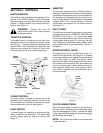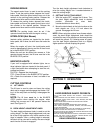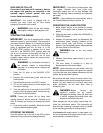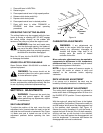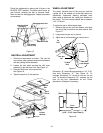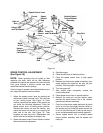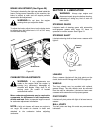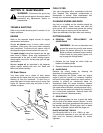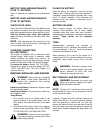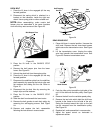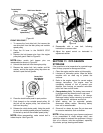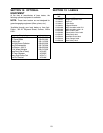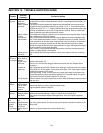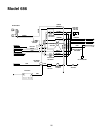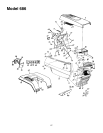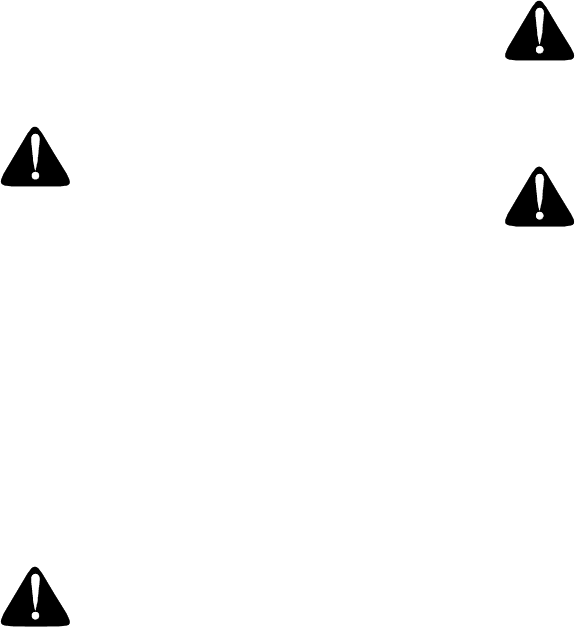
20
BATTERY CARE AND MAINTENANCE
(TYPE “A” BATTERY)
Type “A” batteries are sealed and are maintenance
free.
BATTERY CARE AND MAINTENANCE
(TYPE “B” BATTERY)
CHECK FLUID LEVEL
Check fluid level inside each cell of the battery every
two weeks and before and after charging. Always
keep level between maximum and minimum fill level.
Add only distilled water. Never add additional
acid or any other chemicals to the battery after initial
activation.
NOTE: After operating the lawn tractor for a long
period of time, check the fluid level in the battery as
it can overheat and lose fluid.
CHARGING THE BATTERY
(ALL BATTERIES)
The engine is equipped with an alternator which
charges battery when tractor is operated. Under
normal conditions, the battery only needs to be
charged before, during and after off-season storage.
Follow the instructions under “Off-Season Storage.”
To charge the battery: Battery P/N 725-1705D—
Charge at 2-3 amps for one hour. Battery P/N 725-
1707D, 725-0453G and 725-1750—Charge at 6
amps for one hour.
REMOVING / INSTALLING / JUMP STARTING
WARNING: When removing or installing
the battery, follow these instructions to
prevent the screwdriver from shorting
against the frame.
Removing the Battery: Disconnect negative cable
first, then positive cable.
Installing the Battery: Connect positive cable first,
then negative cable.
Jump Starting
1. First, connect end of one jumper cable to the
positive terminal of the good battery, then the
other end to the positive terminal of the dead
battery.
2. Connect the other jumper cable to the negative
terminal of the good battery, then to the FRAME
OF THE UNIT WITH THE DEAD BATTERY.
WARNING: Failure to use this procedure
could cause sparking, and the gas in either
battery could explode.
CLEAN THE BATTERY
Clean the battery by removing it from the unit and
washing with a baking soda and water solution. If
necessary, scrape the battery terminals with a wire
brush to remove deposits. Coat terminals and
exposed wiring with grease or petroleum jelly to
prevent corrosion.
BATTERY FAILURES
Some common causes for battery failure are:
incorrect initial activation, lack of water, adding
chemicals other than water after initial activation,
undercharging, overcharging, corroded connections,
freezing. These failures do not constitute
warranty.
TIRES
Recommended operating tire pressure is
approximately 10 p.s.i. Maximum tire pressure under
any circumstances is 30 p.s.i. Equal tire pressure
should be maintained on all tires.
When installing a tire to the rim, be certain rim is
clean and free of rust. Lubricate both the tire and rim
generously. Never inflate to over 30 p.s.i. to seat
beads.
WARNING: Excessive pressure (over
30 p.s.i.) when seating beads may cause
tire/rim assembly to burst with force
sufficient to cause serious injury.
BELT REMOVAL AND REPLACEMENT
WARNING: Disconnect the spark plug
wire(s) and ground it against the engine.
Block the wheels of the unit.
NOTE: Figures 23, 27 and 28 are shown with the
unit tipped up for clarity. It is not necessary to tip the
unit to remove the belts.
However, if tipping the unit is desired, remove the
battery from the unit. To prevent gasoline leakage,
drain the gasoline, or remove the fuel tank cap,
place a thin piece of plastic over the neck of the fuel
tank and screw on the cap. Be certain to remove the
plastic when finished changing the belts. Block unit
securely.



